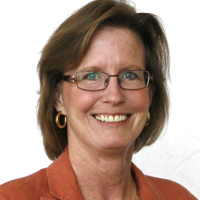
Tech Trends For ’22: Cloud Still Looms Above All

2021 has been a year of significant change in media technology as broadcasters refined remote production workflows created in 2020 to deal with the COVID-19 pandemic. The year has also seen further growth for streaming services and the rollout of NextGen TV broadcasts in a number of major markets. And once again, the year saw the cancellation of the industry’s two major trade shows, NAB and IBC.
But broadcasters’ steady march to public cloud technology was the biggest story in 2021 and will likely continue to be next year, driven by a focus on new direct-to-consumer businesses and a permanent shift to remote and/or distributed production methodologies. That was the takeaway from Technology Trends 2022, a TVNewsCheck virtual event that gathered top executives from the station, network, vendor and consulting fields to forecast next year’s hot tech topics.

Janet Gardner
“We’re really seeing a push to be consumer-first by the large entertainment companies,” said Janet Gardner, president of consulting firm Perspective Media Group, who cited streaming services like WarnerMedia’s HBO Max, NBC Universal’s Peacock and ViacomCBS’ various streaming businesses (which include the free Pluto TV and the subscription Paramount +).
“That drives us toward the importance of data, data as a key trend,” she said. “Capturing data has always been a huge challenge. But now we’re seeing automated metadata extraction and automated QC [quality control]. We also see trends toward the actual management of that information moving away from traditional monolithic systems, much more towards distributed services and virtualization driving our way to the cloud.”
Gardner said the increase in multiplatform delivery, including a wave of new FAST (free ad-supported streaming TV) channels, means more investment in public cloud platforms as well as a sharpened focus on data. That means tracking data through the entire lifecycle of a program asset, all the way from the metadata on the “left side” of the media supply chain to measurement data on the “righthand side,” or fulfillment at the consumer end, in order to get a full picture of what’s being consumed in which geotargeted market.
“They want to manage a full view of data and need to gather first-person data and link it back to programs and versions and elemental content,” Gardner said. “They have versions and need to link metadata with actual media elements and what’s being consumed in which geotargeted market.”
While data is obviously critical for monetizing entertainment programming, Stephane Guez, co-founder and CTO of production software vendor Dalet, sees data as having equal importance for broadcaster’s news content.

Stephane Guez
“Today each piece of media has its own lifecycle,” Guez said. “It’s not tied to a schedule or anything like that. It needs to be discovered, which can be done with our own workflows, to drive personalization, distribution and recommendation. Those are things that are outside of the traditional television realm where the audience has no choice, they’re just consuming what’s proposed. Now it’s the other way around. It’s consumer-first in every step of that process.”
Beside multiplatform delivery, the other big driver toward more software-based orchestration in the cloud is the shift to remote production and hybrid remote/on-premise work models that occurred due to the pandemic. Dalet will be launching Dalet Pyramid in 2022, a new production platform aimed at better serving remote and hybrid news production.
The cloud-native solution will have orchestrated containers and microservices designed for easy deployment in the cloud, Guez said, but will also have an architecture flexible enough so that it can be deployed in private data centers or on-premise. It will also include a web-based video editor to give journalists the “possibility to do everything from everywhere.
“Our mission is to bring the newsroom to users where they are,” Guez said. “Instead of saying you have to come to the newsroom, and this is where you are going to do your work. No — now it’s bring the UX screens of the newsroom to the users wherever they are. Which means also to focus on collaboration, because this is the difficult aspect — how do you [provide it for] people whose job is naturally a collaborative, creative effort if they’re not in the same place.”

Michael Koetter
With the sale of CNN Center in Atlanta, WarnerMedia is aggressively moving as many operations to the cloud as possible and consolidating data centers where it can’t, said Michael Koetter, SVP, production technology for WarnerMedia. It is also creating REMI-style production models where it can, even for fixed production environments. For example, CNN’s Washington bureau will have a REMI model into WarnerMedia’s Techwood campus in Atlanta.
The cloud migration includes recording of news feeds, editing, production storage and CNN’s robust 35-year video library. All of the ingest for CNN’s D.C. bureau is being recorded into AWS right now, and CNN has also moved a substantial portion of the editing (more than 100 editors) for its CNN+ digital product into the cloud. And the production team just finished its first story for CNN International fully in the cloud.
“It’s really happening, and it’s like a freight train,” Koetter said. “We’re all really excited because it’s working, and it’s working really well.”
Another focus for Koetter’s team is further evolving studio production, including both green-screen-based virtual set technology and “virtual production” that relies on high-resolution LED displays as backdrops. The Warner Bros. studio has just launched two large virtual production sets, including one at its Leavesden, U.K., complex that is being used to produce HBO’s Game of Thrones prequel House of the Dragon. WarnerMedia has also been starting to bring virtual production technology into Major League Baseball and National Hockey League coverage on TBS and TNT, as well as CNN.
“There’s a lot of very new and really cool stuff that’s happening in the traditional studio production environment that’s really changing the way those environments work,” Koetter said.
Station owner Graham Media Group has been gradually virtualizing workflows across its stations to simplify their infrastructure, moving functions from dedicated systems to software applications running on COTS hardware. A big technology focus for the first quarter of 2022 will be starting a project to bring its archive into the cloud, said Graham VP and CTO Tony Plosz. Plosz said his focus remains on virtualization as opposed to the cloud and noted Graham will only pursue the public cloud where it makes financial sense.

Tony Plosz
“That’s our first big step from a station side into the cloud, and taking advantage of everything it has to offer,” Plosz said. “We want to be really continuing that trend [of virtualization] and evaluate other workflows that are a good fit in the cloud, see how we can scale some of the stuff CNN is doing.”
Graham’s other technology priority for 2022 is the deployment of ATSC 3.0, which Plosz said “is really going to be huge for us.”
Graham just launched 3.0 broadcasts in Houston, its third “NextGen TV” market after Detroit and Orlando. Graham isn’t a “lighthouse” station in any of those markets, but as its rollout continues, Plosz said the group hopes to fire up its own stick in 2022 and “start to learn firsthand as a broadcaster really what all of the 3.0 capabilities are.” He added that Graham’s digital team has been working hard with the Pearl consortium to develop a polished ATSC 3.0 consumer app for NextGen TV sets that it is looking forward to unveiling.
“As we go forward into 2022, I think you’ll start to see broadcasters and vendors unpack the standard a little bit more,” Plosz said. “There’s a lot in there, a ton of things we haven’t even scratched the surface of yet.”


































Comments (0)